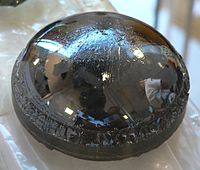
Photo from wikipedia
Silicon carbide coated onto Hi-Nicalon Type S fiber is of great interest to the aerospace industry. This work focuses on tuning the reaction parameters of atmospheric pressure SiC CVI using… Click to show full abstract
Silicon carbide coated onto Hi-Nicalon Type S fiber is of great interest to the aerospace industry. This work focuses on tuning the reaction parameters of atmospheric pressure SiC CVI using CH3SiCl3 to control the morphology of the coatings produced. Depth of CH3SiCl3 from 1 to 14 cm, temperature from 1000 to 1100 °C, and flow rate of H2 carrier gas from 5 to 30 SCCM were examined. Coating morphologies ranged from smooth to very nodular, where spherical growths were present along the entire deposition zone. The parameters that yielded a smooth deposition throughout the 20 cm deposition zone were 4–6 cm of CH3SiCl3(l) depth, 1100 °C, and 10 SCCM of H2 as a carrier gas. Tensile testing using acoustic emission sensors was performed on SiCf/BN/CVI-SiC minicomposites with different coating morphologies. The tensile tests revealed that smooth coatings have better mechanical performance than the nodular coatings; nodular coatings promote premature ultimate brittle failure, while smooth coatings exhibit toughening mechanisms. Smooth coatings had higher average matrix cracking strength (248 MPa) and ultimate tensile strength (541 MPa) than average nodular coating matrix cracking strength (147 MPa) and ultimate strength (226 MPa).
Journal Title: ACS Omega
Year Published: 2020
Link to full text (if available)
Share on Social Media: Sign Up to like & get
recommendations!